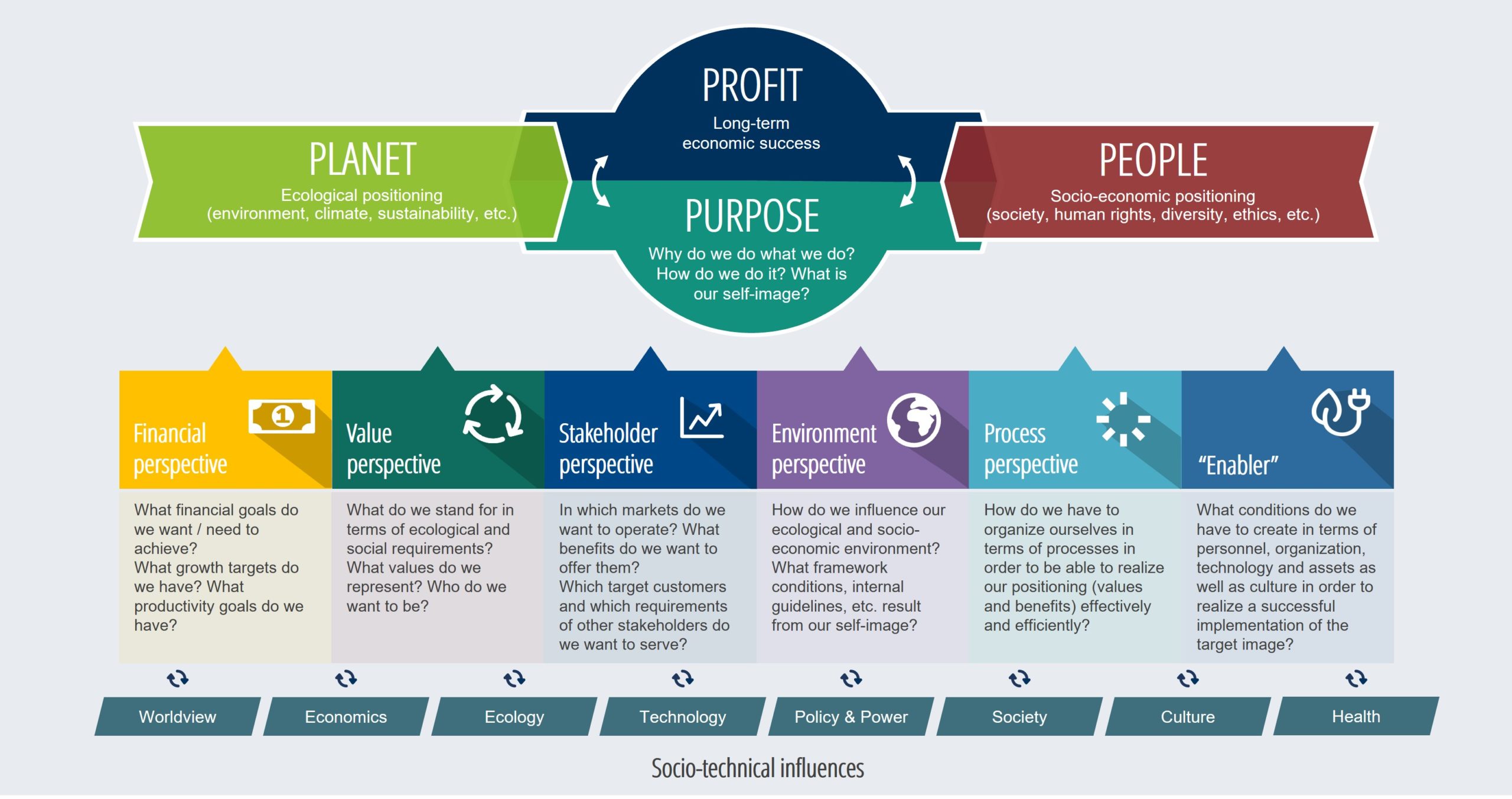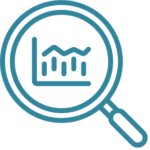
Strategy map for sustainable corporate development
Purpose | Planet | People | Profit
In a changing world, it’s all about having the right points of reference.
With our strategy map for sustainable corporate development, we work with you to develop a viable strategy that takes into account not only the financial perspective, but also the environmental and social requirements and goals, as well as the relevant strategic levers.
Develop your organization with us in a target-oriented and sustainable way.
 Frédéric SedlákSenior Consultant | HR Management
Frédéric SedlákSenior Consultant | HR ManagementWe are always at your service+49 4102 69 93 22
Ask for free informationf.sedlak@spconsulting.de
Strategies for the development of future viability
Only if an organization knows what it wants to achieve and what it needs to achieve it, it can deploy its resources in a targeted manner and be successful in the long term. A viable strategy provides the necessary orientation for day-to-day operations. It makes it possible to maintain organizational decision-making capability even under uncertain conditions.
The same applies to issues of organizational responsibility and sustainability – here, too, managers and staff need clear points of orientation. Just talking about sustainability is no longer an option today. Organizations are required to position themselves credibly and to act in accordance with their own statement. Customers, employees, and other stakeholders will quickly notice if the topic of sustainability is merely used as an image-building measure, and will sanction this behavior.
Credibility and the ability of management and staff to speak out on sustainability issues can only be achieved if these positioning statements are also strategically anchored and understood as well as internalized. For this reason, we have extended the “classic” strategy map according to Kaplan and Norton to include several perspectives and thus provide an effective instrument for linking the different perspectives in a strategic context.
Shape the future with us purposefully
Book an appointment directly through our booking system for an online dialogue with our strategy development and implementation consultants or secure valuable information on the use of the Strategy Map for sustainable business development:
Strategy Map for Sustainable Corporate Development
What is a Strategy Map?
The Strategy Map is a structured and comprehensive framework for describing and implementing strategy. On one page, it visualizes the strategy and explicit impact relationships between the identified levers in the perspectives:
- Finances
- Stakeholders (incl. customers)
- Processes
- “Enabler“ (Learning/Development)
The strategy map for sustainable corporate development also includes the two complementary perspectives:
- Value
- Environment
Strategy Map for Sustainable Corporate Development
Purpose | Planet | People | Profit
What added value does a strategy map provide?
The best strategy is worthless if it is not understood and implementation fails. It is therefore crucial that all employees are familiar with the strategy and can understand how it affects their day-to-day work. The strategy map can make a significant contribution to this.
With the development of the strategy map, a consistent cause-effect structure is visualized. In the process, all essential levers for implementing the strategy are identified, interconnected, and checked for plausibility. This ensures that resources are focused on the activities with the greatest leverage for effective strategy implementation and successful target achievement.
Strategy Map
- illustrates the working hypotheses underlying the strategy,
- creates a shared awareness of the interrelationships between the individual elements of the strategy,
- gives structure and orientation and
- shows the reciprocal effects within the strategy.
It is therefore also an essential communication tool that can be used to present strategic goals in the customer and financial perspective and the resulting measures in the process and development perspective in a comprehensible way. Or, to put it another way: the strategy map clarifies which contributions are to be made at the respective perspective levels, taking into account the defined value system, in order to achieve the strategic goals that have been set.
What distinguishes the strategy map for sustainable corporate development from the conventional strategy map and why was this expansion necessary?
The strategy map for sustainable corporate development differs from the conventional strategy map in that it integrates the environmental and values perspective. Relevant issues here are:
- Why do we do what we do? How do we do it and what values do we represent?
- How do we position ourselves ecologically and socio-economically?
- Where and how do we influence our ecological and socio-economic environment? What internal framework conditions do we set for ourselves with our self-image?
This broadening of perspectives is necessary because organizations are dependent on the acceptance of their relevant environments – and sustainable and responsible action is increasingly demanded both socially and politically. The legal regulations will also place stricter requirements on corporate responsibility in the future. The social benefit will increasingly influence the purchasing decisions of customers and consumers.
There are no shortcuts in the necessary transformations; they will take a lot of time and resources. Companies that start too late run the risk of missing the boat.
“If companies that are successful under the paradigms still valid today continue to turn a blind eye to these global developments, they may no longer be able to meet legal and social expectations and requirements – and thus no longer offer society any benefits and thus disappear from the market. In view of these crucial changes, it is essential for companies to act with foresight and anticipate regulations at an early stage.“
– Robert A. Sedlák
CEO S&P Consulting
Guest Professor at the ECNU, Shanghai

Shape your future with us
No organization is like another – which is why we always tailor our consulting services in a strategic context, taking into account the specific needs of our clients and the individual DNA of the company. Within the scope of the service modules listed below, we analyze your development needs and work with you to create holistic development plans for the targeted further development of your strategy and for an organizational transformation that takes current requirements into account.
Entry into sustainable corporate development
Strategy-Review
Review of your current strategic positioning, taking into account current market developments, trends and requirements for climate neutrality and digitalization, and examination of the perspectives of the strategy map – finance, values, stakeholder, environment, processes, and learning and development (“enablers”).
Duration:
1 – 2 day workshop
Result:
- Concretization of the strategic positioning
- Recommendations for strategy implementation and organizational anchoring of the future vision
 Strategy ReviewSenior consultant and authorized officer
Strategy ReviewSenior consultant and authorized officerWe are always at your service+49 4102 69 93 0
Ask for free informationf.sedlak@spconsulting.de
Strategy development including system intelligence
We link internal and external knowledge, experience and assessments in a customized process architecture so that new insights are generated. These insights are transferred to the strategy map, taking into account ecological and socio-economic factors. You get intelligent and new solutions and at the same time generate the highest level of commitment from all stakeholders as the basis for successful implementation.
Duration:
3 – 6 months
Result:
- Target clarity for the organization in terms of strategic positioning
- Concretization of target/actual differences as a benchmark for all employees and in the organization for the implementation process
- Consolidation of commitment in the management team as a basis for the development of a strategy map and the associated implementation processes
 Strategy ReviewSenior consultant and authorized officer
Strategy ReviewSenior consultant and authorized officerWe are always at your service+49 4102 69 93 0
Ask for free informationf.sedlak@spconsulting.de
Download background information on the Strategy Map
Strategy Map for sustainable business development as well as background information on the application
Download for free the digital presentation on the Strategy Map for Sustainable Business Development, including templates and background information on how to use it in strategy work.
In dynamic and uncertain market situations, it is not the current response behavior of an organization that establishes competitive advantage, but the long-term design of response capabilities and key resources.

Strategy map for sustainable corporate development
Purpose | Planet | People | Profit
Strategy work in the context of organizational transformation
Elements for sustainable change in organizations
Organizational transformation is a challenging process whose success depends to a large extent on whether managers and employees rationally and emotionally understand the strategic goals and support the changes to achieve them. This applies across all industries, whether in the automotive industry, mechanical engineering, IT, finance and administration, the chemical industry, or even the energy sector. Within the framework of our intervention architecture, we integrate initiatives at the levels of strategy, organization, and personnel, thus enabling successful transformation in a strategic context:
Developing an attractive future vision
For orientation, an organization needs a meaningful and attractive future vision that employees know, understand and live. The future vision encompasses the future business policy identity and the associated future strategic positioning. An authentic future vision that takes the organization’s emotions seriously provides orientation and motivates managers and employees.
Market, customer, and environment analysis
How well do you really know your market and your customers? The collection of valid outside-in data by us on market developments, competitive strengths, customer expectations and potential, as well as relevant framework conditions, which are concretely incorporated into the process of strategy development or sharpening of the existing strategy, provide clarity and deliver added value.

Strategy Map for Sustainable Corporate Development
A strategy cannot be implemented if it is not understood. A strategy cannot be understood if it cannot be clearly described. The Strategy Map provides certainty and is a structured and comprehensive framework for strategy description and implementation. Our extension of the Strategy Map allows external environmental and socio-economic effects to be directly and concretely incorporated into strategy work.
Reflect leadership and communication structure
Organizations thrive on decisions being made. Without communication, there are no decisions; without decisions, things grind to a halt. The introduction of suitable communication platforms and routines represents an essential success factor for arriving at viable decisions in strategy work. Here, the available information and impulses are discussed, reflected upon and differentiated in an adequate form – always with the thematically relevant players at the table.
Strategy implementation and effectiveness monitoring
Successful strategy implementation requires a clear distinction between the timely and formal implementation of strategic measures and the degree of target achievement. Effectiveness monitoring measures the achievement of objectives in the financial and customer perspective, while implementation monitoring measures the degree of implementation of strategic measures in the process and learning or development perspective.
Learning architectures to strengthen innovation capabilities
An interlocked organizational and personnel development enables organizations to face changes and the growing complexity with more ease. Learning architectures ensure that the necessary development of competencies on the part of employees is dovetailed with the implementation of appropriate organizational frameworks in order to be able to meet changing requirements.
LET'S TALK
Long-term success in the fast-moving age of digitalization and climate neutrality.
As an experienced systemic organizational consultancy, S&P Consulting understands how to successfully orchestrate the levers for the holistic transformation of your organization, effectively strengthening its resilience and adaptability.
Contact us and learn more about our consulting approach in a personal online dialogue.
We look forward to talking to you in person!

Julia Kobert
Head of Corporate Communications
 Frédéric SedlákSenior Consultant | HR Management
Frédéric SedlákSenior Consultant | HR ManagementWe are always at your service+49 4102 69 93 22
Ask for free informationf.sedlak@spconsulting.de

Frédéric Sedlák
Senior Consultant and Authorized Officer
 Frédéric SedlákSenior Consultant and Authorized Officer
Frédéric SedlákSenior Consultant and Authorized OfficerWe are always at your service+49 4102 69 93 22
Ask for free informationf.sedlak@spconsulting.de












